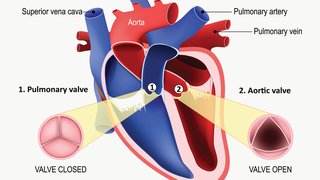Study uncovers link between two key risk factors for first-time heart attack, stroke
February 23, 2022

High cholesterol and hypertension are well-established conditions that can increase your risk of a heart attack – and because of that both are monitored regularly with blood tests and blood pressure readings.
Two lesser-known predictive factors of cardiovascular disease are not as commonly tested for in the U.S.: lipoprotein(a), a type of bad cholesterol whose levels are driven largely by one’s genes; and coronary artery calcium (CAC), a marker of plaque deposits around the heart.
Individually, both have been associated with increased risk of atherosclerotic cardiovascular disease (ASCVD). But new research by UT Southwestern’s Preventive Cardiology team has found that patients with both a high lipoprotein(a), or Lp(a), and high CAC score face a very high heart attack or stroke risk – more than 20% over the following 10 years.
For perspective, that is approximately the risk level of suffering a second heart attack in a person who has already had one.
We confirmed the Lp(a) and CAC connection by comparing data from two landmark cardiovascular trials:
- The Dallas Heart Study, an ongoing comprehensive study of 6,000 diverse and heart-healthy patients conducted by UT Southwestern from 2000 to present
- Multi-Ethnic Study of Atherosclerosis (MESA): A 6,000-participant study investigating early-stage atherosclerosis (hardening of the arteries).
Our new research was published online by the Journal of the American College of Cardiology (JACC) and will appear in the March print edition.
We are hopeful that by making the connection between Lp(a) and CAC as dual risk drivers, we can raise awareness in the medical community and improve earlier heart attack prevention for these patients. Our data may also expedite the development of treatments designed specifically for this high-risk population.

Lp(a) basics
Lp(a) is a cholesterol particle whose level in the blood is determined mainly by genetics. An Lp(a) reading over 50 mg/dL or 125 nmol/L is considered high. Approximately 1 in 6 people in the U.S. have high Lp(a), which increases heart attack risk.
Most physicians don’t screen for the condition, either because they aren’t aware of it or because there is no specific treatment for it. But knowing whether a patient has elevated Lp(a) may be a valuable tool in assessing their overall cardiovascular risk. Lp(a) is measured with a simple blood test. Some people with high Lp(a) also receive a one-time genetic test to look for a genetic mutation causing elevated for Lp(a), which is a specific type of familial hypercholesterolemia.

CAC basics
A CAC score is obtained from a dedicated heart CT scan, which uses lower amounts of radiation than a regular CT scan. The test itself is very quick and can identify traces of calcium in the heart arteries, which occur when someone has cholesterol buildup in their artery walls that “calcifies.”
In older adults, excessive CAC reflects extensive plaque in the arteries and is associated with higher risks of heart attack and stroke. In younger adults, any CAC is concerning and should prompt a discussion with a doctor about lowering heart disease risk.

Treatments for Lp(a) and CAC
Whereas there is no therapy currently on the market that has been FDA approved to lower Lp(a), several are in development. For now, doctors recommend treating overall cardiovascular risk in people with high Lp(a). Proven strategies to reduce cardiovascular risk in patients with high Lp(a) or high coronary calcium include taking a cholesterol-lowering medication called a statin to reduce non-Lp(a) cholesterol circulating in the blood and a combination of medication and lifestyle changes such as:
- Achieve a healthy weight
- Control blood pressure
- Exercise regularly (recommendation is 150 minutes a week of moderate intensity exercise of 75 minutes a week of high intensity exercise)
- Manage diabetes
- Eat a healthy diet (avoiding excess sugar, trans- and saturated fats, and increasing fruit and vegetable intake)
- Quit smoking
Discovering the connection
Often, Lp(a) and CAC are viewed independently as risk factors. Understanding the interplay of CAC and Lp(a) can become crucial to guiding effective prevention strategies.
The Dallas Heart Study and MESA both included a diverse population of healthy patients and tested for Lp(a) and CAC. After 20 years, the youngest Dallas Heart Study participants are now middle-aged – when the risk of heart attack begins to increase.
Our researchers found that participants with combined high Lp(a) and high CAC had a 22% 10-year risk of heart attack or stroke, compared with 10-15% 10-year risk in patients who had either risk factor alone. We identified three distinct risk-related trends:
- High Lp(a), high CAC: These individuals face the highest 10-year risk of heart attack or stroke.
- High Lp(a), zero CAC: 10-year heart attack and stroke risk is low when there is no CAC, even if Lp(a) is high.
- Low Lp(a), high CAC: 10-year heart attack or stroke risk is higher than average but lower than with high LP(a) and high CAC combined.
Establishing the connection between Lp(a) and CAC means we can move to the important next phase of research, which will be defining and personalizing early screening protocols to identify patients at high risk of heart attack. With further research, this could mean selectively scanning patients with high Lp(a) for their CAC score, and studying therapies specifically designed to reduce Lp(a) among patients with high CAC.
Related reading: MESA 10-Year CHD Risk Calculator
Meet Dr. Joshi
Parag Joshi, M.D., is a preventive cardiologist who helps patients identify and reduce their risk for heart disease. In addition to treating patients, he is a very active researcher and mentor to future cardiologists.
The future of heart attack risk assessment
Not every patient is keen on taking daily statins to lower their risk. But diet and exercise alone cannot fully control high cholesterol for many patients and has limited effects on Lp(a) in particular. The optimal solution for those with high Lp(a) will be to develop a preventive therapy for patients who are most at risk. And we are on the leading-edge of research happening now for just such a future discovery.
UT Southwestern is a site for the phase III Lp(a) HORIZON trial, an international research study of more than 7,000 patients with high Lp(a) who have already had a stroke or heart attack and take cholesterol medication.
I am the principal investigator of our site for the study, which is directed by Novartis Pharmaceuticals and aims to determine whether the injectable drug TQJ230 – an investigational agent that has been shown to reduce Lp(a) levels by 80% – can reduce the risk of a second heart attack or stroke.
As research progresses, UT Southwestern continues to push the envelope of primary prevention – helping patients avoid a first heart attack altogether. Part of our effort is continually encouraging the development of more therapies tailored to the unique needs of patients with high Lp(a) and CAC. Our hope is that over the next three to five years, our passion for risk reduction in this vulnerable population will culminate in extending the findings from studies like the HORIZON trial to those at high risk for a first heart attack. Our findings help identify those patients with a high Lp(a) who have not had a heart attack or stroke but are at highest risk for a first event when they have a high CAC score.
Cardiovascular risk reduction is a two-way street, however. Patients must feel comfortable with the medications and therapies we recommend. And providers must understand the implications of asking patients to undergo additional screenings, change their lifestyle, or take a daily pill – though highly effective, misinformation about lifesaving statins abounds.
Discuss your options with a preventive cardiologist if you have a family history of early, unexplained heart attack or stroke and want to learn more about your Lp(a) or CAC score. Call 214-645-8000 or request an appointment online..











